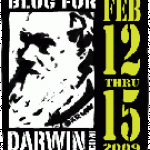Science
Unfortunately, as we have been dreading for the last four months or so since her relapse was diagnosed, my mother-in-law passed away from breast cancer in hospice. She died peacefully, with my wife and the rest of her family at her side. As you might expect, I do not much feel like blogging, and even if I did my wife needs me more. Because I foresaw this coming, however, I do have a series of "Best of" reposts lined up. If you've been reading less than a year or two, they're new to you. If not, I hope you enjoy them again. I don't know when I'll be back, other than maybe a brief update or two…
A few days ago, Bee put up a post titled Do We Need Science Journalists?, linking back to Bora's enormous manifesto from the first bit of the Horgan-Johnson bloggingheads kerfuffle. My first reaction was "Oh, God, not again..." but her post did make me think of one thing, which is illustrated by Peter Woit's latest (no doubt a kerfuffle-in-the-making).
Bee quotes Bora urging bloggers to keep twirling, twirling, twirling toward the better day when scientists communicate to the general public, without all the hype and exaggeration:
Perhaps if we remove those middle-men and have scientists and…
An article by Evan Mills, a staff scientist at Lawrence Berkeley National Laboratory, points out that scientific buildings use a lot more energy than average:
Improving energy productivity is a doubly worthy challenge, given that those making the biggest contributions to the science of sustainability often do so in highly energy intensive facilities such as laboratories, computing centers, and hyper-clean environments. There is a long way to go to meet the sustainable practices. According to a U.K. Department for Environment, Food, and Rural Affairs survey, virtually all interviewed…
I've already mentioned two of the program items I was on at Boskone (global warming and quantum physics for dogs). I should at least comment on the other two, "Physics: What We Don't Understand" and "Is Science Addicted to Randomness?" They both featured me and Geoff Landis, but other than that were very different.
"Physics: What We Don't Understand" took off from a column by John Cramer from ten years ago, laying out seven big problems in (astro)physics that hadn't been solved. We talked about how some of Cramer's items have been more or less solved (gamma-ray bursts, solar neutrinos, and…
The Taliban Beetle, a specimen at the Naturhistorisches Museum Basel, Switzerland.
Meet the Taliban Beetle.
I took this picture in 2004 while visiting the collections at the Natural History Museum in Basel, Switzerland. For reasons I was unable to discern, a coleopterist working in the collection in the late 1990's had intended to name this new Afghani ground beetle after the country's ruling party at the time. Whether he came to regret this decision in the post 9/11 world, I do not know.
No formal description of the Taliban beetle was ever printed. So despite the…
Pheidole dentata, older worker with larva.
A study out in pre-print by Muscedere, Willey, and Traniello in the journal Animal Behaviour finds little support for a long-held idea that worker ants change specializations to perform different types of work as they age. By creating colonies out of different age classes in the ant Pheidole dentata, the researchers showed that older workers were good at pretty much everything, while younger ants performed only a few tasks, but did those less efficiently. Here is the abstract:
Age-related task performance, or temporal polyethism, is a…
I no longer remember the context, but the Gravity Probe B experiment came up in discussion around the department last week, and nobody could really remember what the status of it was. It came up again during the "Physics: What We Don't Understand" panel Saturday morning, where Geoff Landis was able to supply a few details from inside NASA. It came up again during a later panel on the year in physics and astronomy, and again, Geoff was able to supply some details.
I'm not sure what the deal is, but there's evidently something in the air at the moment making people think about Gravity Probe B,…
So Amanda and I arrive at some public building in a largish Midwestern city. I'm a scientist, here to sit on a panel for a public discussion related to science and education. The building, a library, is not open yet but is scheduled to open in a few minutes. There are two groups of people standing in the flurries and chilly wind waiting for opening. The larger group is pressed against the door, seemingly anxious, and I (incorrectly, it turns out) attribute this anxiety to the cold. I'm thinking they want to go inside because it is cold. All but two people in this group are brown to dark…
While reading the New Yorker yesterday I came across this gem of a quote from the late John Updike, which eloquently expresses one of the ideas I was reaching for in my own Darwin Day post.
The non-scientist's relation to modern science is basically craven: we look to its discoveries and technology to save us from disease, to give us a faster ride and a softer life, and at the same time we shrink from what it has to tell us of our perilous and insignificant place in the cosmos. Not that threats to our safety and significance were absent from the pre-scientific world, or that arguments against…
On Saturday at Boskone, I gave a talk on the Many-Worlds Interpretation of QM. This was held up a bit by waiting for the projector to arrive (I was busy enough with other stuff that I didn't notice that I hadn't received confirmation of my request for a projector until late Thursday night, so this was entirely my fault). They were able to come up with a projector, sparing people the need to squint at my tiny tablet PC screen, but it took some time off the beginning of the talk.
The talk consisted of me reading the dog dialogue from Chapter 4 (not to different from the original post), then…
Myrmecologist extraordinaire Mike Kaspari sends out the following call to arms:
I am working on a project with Jamie Gillooly examing how various life history traits scale in ant colonies. Specifically, we are testing the hypothesis that when total colony mass is used (instead of the mass of an individual in the colony) social insects scale much like their unitary counterparts.
From the subject heading, you can see where I am going with this. Allometries need to be tested across the entire natural range of variability, and a regression of total worker mass against queen mass (of…
Sunday morning at Boskone, I moderated a panel on "Global Warming: Facts and Myths, (and all that jazz)", featuring James Morrow, Mark Olson, and Vince Docherty. As noted previously, I was a little worried that this would turn out to be absolutely awful in one of a couple of obvious ways, but it wound up being pretty good, all things considered.
The panelists were all pretty much on board with my request to try to keep from being soul-crushingly depressing, and a lot of the discussion focused on things that can be done to mitigate the worst effects of global warming. The whole thing was…
Who is supposed to read The Superorganism?
I can't really tell. While I'm enjoying Holldobler & Wilson's latest tome, I am perplexed at the book's target audience. The text switches between broadly anthropomorphic prose clearly aimed for a general audience and obtuse jargon digestible only by the experienced biologist.
I get the feeling that the authors- at least one of them, anyway- desired a technical book more along the lines of Bourke & Franks, while the marketing department at Harvard University Press wished to trade on the authors' name recognition with a glossy…
These Periodic Table of Sentiments cards by Pink Loves Brown are the atom bomb. Happy Birthday is represented by element Hb, etc. So clever!
But why isn't there a Valentine's Day card suitable for telling that special geek about your deep chemical attraction? What could say "love" better than element Vd??
Believe it or not, I had to write out Vd before I saw the obvious problem. What a catastrophic holiday FAIL that would be. . . I shudder at the thought.
ok, thomas.loc.gov now has the final version of the stimulus bill as being put to the vote to be sent to Obama - this is the House/Senate conference compromise plus extra bits the Speaker's office insisted upon after being unhappy with the Senate prematurely announcing agreement.
It is good for science, as good as can be expected. Maybe a bit too good in that we might pay a price later.
Interesting clause on executive compensation limitations.
PS: Bill has now passed senate and house and goes to President Obama for signature.
Not that I'm a worrywart or anything.
Ok, this particular…
In a potentially exciting development, researchers have announced the completion of a rough draft of the Neandertal genome in a talk at the AAAS, and in a press conference, and the latest issue of Science has a number of news articles on the subject. And that is a reason for having some reservations. There is no paper yet, and science by press release raises my hackles, and has done so ever since the cold fusion debacle. Not that I think this is a hoax or error by any means, but it's not a good way to present a scientific observation.
Also, the work has some major limitations right now. They'…
Dangerous concept; successful execution: From the mediea team at Small Mammal, a cute video story that deconstructs a cute YouTube video to look at the science of cuteness.
Somebody run tell Liz Spikol!
var gaJsHost = (("https:" == document.location.protocol) ? "https://ssl." : "http://www.");
document.write(unescape("%3Cscript src='" + gaJsHost + "google-analytics.com/ga.js' type='text/javascript'%3E%3C/script%3E"));
try {
var pageTracker = _gat._getTracker("UA-3733673-3");
pageTracker._trackPageview();
} catch(err) {}
I've been a Grumpy Blogger this week, what with one thing and another (some of my general malaise has finally resolved into a cold, which I suspect explains a lot). I'm headed to Boskone for the weekend, though, so let's end the week on a positive note. I'm declaring this a Happy News Open Thread: if you've got something positive to report, leave it in the comments.
some happy thoughts to get things started:
Two of Union's librarians (one of whom is a regular in our lunchtime basketball games) have won an award from the American Library Association. Congratulations, Bruce and Gail!
One of…
Yesterday I prepared to write my Darwin Day post by attending a panel discussion at the Center For American Progress here in DC. The discussion was ostensibly about "evolution, transcendence, and the nature of faith," which led my friend Colin and I to hope for a spirited debate - perhaps even a die-hard creationist who would speak for the three-quarters of frequent churchgoers who don't accept evolutionary theory! But what we got was a predictable, rather boring discussion - at least until David Sloan Wilson arrived and threw me for a loop.
The first two panelists were Rev. Dr. Susan Brooks…
Here's a sharper version:
Parasitic Cotesia wasp attacks a Manduca larva
The story itself is amazing. It's been known for some time that Ichneumonid and Braconid wasps inject circular strands of DNA- called polydnaviruses- into their host insects along with their eggs. This DNA is encoded by the wasp genome but acts like a virus in their hosts, dismantling the immune system to protect the developing wasp larvae. In a study out this week in Science, a team headed by Jean-Michel Drezen pinpointed the origin of the polydnavirus as being a type of nudivirus. It…

